Mechanical Properties of Crumb Rubber Mortar Containing Nano-Silica Using Response Surface Methodology
Abstract
1. Introduction
2. Materials and Methods
2.1. Materials Compositions and Properties
2.2. Mix Proportions
2.3. Response Surface Methodology
2.4. Sample Preparations and Test Methods
3. Results and Discussion
3.1. Effect of Crumb Rubber and Nano-Silica on Hardened Properties of NS-CRM
3.1.1. Compressive Strength
3.1.2. Flexural Tensile Strength
3.1.3. Direct Tensile Strength
3.1.4. Drying Shrinkage
3.1.5. Modulus of Elasticity
3.1.6. Poisson’s Ratio
3.2. Mathematical and Statistical Models Using Response Surface Methodology
3.2.1. Response Surface Methodology Modeling
3.2.2. Statistical Models and Analysis of Variance
3.2.3. Optimization and Experimental Validation
3.3. Microstructural Analysis of NS-CRM
3.3.1. Scanning Electron Microscope
- CR7.5-NS0
- 2
- CR7.5-NS2.5
- 3
- CR7.5-NS5
3.3.2. Mercury Intrusion Porosimetry
4. Conclusions
- The compressive strength, flexural tensile strength, direct tensile strength, Modulus of Elasticity (ME), and Poisson’s Ratio (PR) of crumb rubber mortar containing nano-silica (NS-CRM) decreased as the percentage of crumb rubber (CR) was increased. However, an increase in drying shrinkage and porosity of NS-CRM was observed. This is attributed to the hydrophobic properties of CR which causes an increment of voids in the mixture.
- The compressive strength, flexural tensile strength, direct tensile strength, ME, and PR of NS-CRM increased when 2.5% of nano-silica (NS) was incorporated. However, a decrease in drying shrinkage and porosity of NS-CRM was observed. This is attributed to the pozzolanic reaction of NS and its nanoparticle size.
- The mechanical properties of NS-CRM acted contrariwise when 5% of NS was incorporated. This is attributed to the difficulty of NS to disperse uniformly when excessive NS is used. Hence, a weak zone is created in form of voids; consequently, the homogenous hydrated microstructure cannot be formed.
- The models developed using RSM for predicting the mechanical strengths of NS-CRM were acceptable, with errors less than 5%.
- The interfacial transition zone (ITZ) and cumulative pore volume of CRM were improved with the presence of NS. This is attributed to the physico-chemical effect of NS. However, a high percentage of NS causes the mesopores volume to increase due to agglomeration of unreacted NS which leads to excessive self-desiccation.
Author Contributions
Funding
Institutional Review Board Statement
Informed Consent Statement
Data Availability Statement
Acknowledgments
Conflicts of Interest
References
- Pathak, S.K.; Sood, V.; Singh, Y.; Channiwala, S. Real World Vehicle Emissions: Their Correlation with Driving Parameters. Transp. Res. Part D Transp. Environ. 2016, 44, 157–176. [Google Scholar] [CrossRef]
- Azevedo, F.; Pacheco-Torgal, F.; Jesus, C.; de Aguiar, J.B.; Camões, A. Properties and Durability of HPC with Tyre Rubber Wastes. Constr. Build. Mater. 2012, 34, 186–191. [Google Scholar] [CrossRef]
- Demir, F.; Yesilata, B.; Turgut, P.; Bulut, H.; Isiker, Y. Investigation of The Effects of pH, Aging and Scrap Tire Content on The Dissolution Behaviors of New Scrap Tire-Concrete Mixture Structures. J. Clean. Prod. 2015, 93, 38–46. [Google Scholar] [CrossRef]
- Liu, F.; Li, L.-J.; Xie, W.-F.; Chen, Z.-Z. Experimental Study of Recycled Rubber-Filled High-Strength Concrete. Mag. Concr. Res. 2009, 61, 549–556. [Google Scholar] [CrossRef]
- Sukontasukkul, P. Use of Crumb Rubber to Improve Thermal and Sound Properties of Pre-Cast Concrete Panel. Constr. Build. Mater. 2008, 23, 1084–1092. [Google Scholar] [CrossRef]
- Siddique, R.; Naik, T.R. Properties of Concrete Containing Scrap-Tire Rubber—An Overview. Waste Manag. 2004, 24, 563–569. [Google Scholar] [CrossRef]
- Youssf, O.; El Gawady, M.; Mills, J.; Ma, X. An Experimental Investigation of Crumb Rubber Concrete Confined by Fibre Reinforced Polymer Tubes. Constr. Build. Mater. 2014, 53, 522–532. [Google Scholar] [CrossRef]
- Liu, F.; Meng, L.-Y.; Ning, G.-F.; Li, L. Fatigue Performance of Rubber-Modified Recycled Aggregate Concrete (RRAC) for Pavement. Constr. Build. Mater. 2015, 95, 207–217. [Google Scholar] [CrossRef]
- Eldin, N.N.; Senouci, A.B. Rubber-Tire Particles as Concrete Aggregate. J. Mater. Civ. Eng. 1993, 5, 478–496. [Google Scholar] [CrossRef]
- Topçu, I.B. The Properties of Rubberized Concretes. Cem. Concr. Res. 1995, 25, 304–310. [Google Scholar] [CrossRef]
- Malik, N.H.; Al-Arainy, A.A.; Qureshi, M.I. Electrical Insulation in Power Systems; CRC Press: Boca Raton, FL, USA, 2018. [Google Scholar] [CrossRef]
- Hernández-Olivares, F.; Barluenga, G. Fire Performance of Recycled Rubber-Filled High-Strength Concrete. Cem. Concr. Res. 2004, 34, 109–117. [Google Scholar] [CrossRef]
- Fattuhi, N.; Clark, L. Cement-Based Materials Containing Shredded Scrap Truck Tyre Rubber. Constr. Build. Mater. 1996, 10, 229–236. [Google Scholar] [CrossRef]
- Raghavan, D.; Huynh, H. Workability, Mechanical Properties, and Chemical Stability of a Recycled Tyre Rubber-Filled Cementitious Composite. J. Mater. Sci. 1998, 33, 1745–1752. [Google Scholar] [CrossRef]
- Wongsa, A.; Sata, V.; Nematollahi, B.; Sanjayan, J.; Chindaprasirt, P. Mechanical and Thermal Properties of Lightweight Geopolymer Mortar Incorporating Crumb Rubber. J. Clean. Prod. 2018, 195, 1069–1080. [Google Scholar] [CrossRef]
- Yu, Y.; Zhu, H. Influence of Rubber Size on Properties of Crumb Rubber Mortars. Materials 2016, 9, 527. [Google Scholar] [CrossRef] [PubMed]
- Angelin, A.F.; Andrade, M.F.; Bonatti, R.; Lintz, R.C.C.; Gachet-Barbosa, L.A.; Osório, W.R. Effects of Spheroid and Fiber-Like Waste-Tire Rubbers on Interrelation of Strength-To-Porosity in Rubberized Cement and Mortars. Constr. Build. Mater. 2015, 95, 525–536. [Google Scholar] [CrossRef]
- Herrero, S.; Mayor, P.; Hernández-Olivares, F. Influence of Proportion and Particle Size Gradation of Rubber from End-of-Life Tires on Mechanical, Thermal and Acoustic Properties of Paster–rubber Mortars. Mater. Des. 2013, 47, 633–642. [Google Scholar] [CrossRef]
- Gopinath, S.; Mouli, P.; Murthy, A.; Iyer, N.; Maheswaran, S. Effect of Nano Silica on Mechanical Properties and Durability of Normal Strength Concrete. Arch. Civ. Eng. 2012, 58, 433–444. [Google Scholar] [CrossRef]
- Liu, J.; Li, Q.; Xu, S. Influence of Nanoparticles on Fluidity and Mechanical Properties of Cement Mortar. Constr. Build. Mater. 2015, 101, 892–901. [Google Scholar] [CrossRef]
- Lieftink, D.; Dekker, B.; Geus, J. The Structure of Silica Particles Prepared by Acid Treatment of Olivine: A Nitrogen-Physisorption and 29Si-MAS NMR Study. In Studies in Surface Science and Catalysis; Elsevier: Amsterdam, The Netherlands, 1998; Volume 118, pp. 755–761. [Google Scholar] [CrossRef]
- Jaishankar, P.; Kanchidurai, S.; Mohan, K.S.R. Durability and Pore Structure Analysis of High-Performance Concrete with Nano Silica. Rom. J. Mater. 2020, 50, 478–484. [Google Scholar]
- Roddy, C.W.; Chatterji, J.; Cromwell, R. Well Treatment Composition and Methods Utilizing Nano-Particles. U.S. Patent 7,559,369, 14 July 2009. [Google Scholar]
- Ghanbari, M.; Kohnehpooshi, O.; Tohidi, M. Experimental Study of the Combined Use of Fiber and Nano Silica Particles on the Properties of Lightweight Self Compacting Concrete. Int. J. Eng. 2020, 33, 1499–1511. [Google Scholar] [CrossRef]
- Sakka, S.; Kozuka, H. Handbook of Sol-Gel Science and Technology: Processing, Characterization and Applications; Kluwer Academic Publishers: Boston, MA, USA, 2005. [Google Scholar]
- Sadrmomtazi, A.; Fasihi, A.; Balalaei, F.; Haghi, A.K. Investigation of Mechanical and Physical Properties of Mortars Containing Silica Fume and Nano-SiO2. In Proceedings of the International Conference on Concrete and Development, Tehran, Iran, 27–28 April 2009. [Google Scholar]
- Qing, Y.; Zenan, Z.; Deyu, K.; Rongshen, C. Influence of Nano-SiO2 Addition on Properties of Hardened Cement Paste as Compared with Silica Fume. Constr. Build. Mater. 2007, 21, 539–545. [Google Scholar] [CrossRef]
- Li, H.; Xiao, H.-G.; Ou, J.-P. A Study on Mechanical and Pressure-Sensitive Properties of Cement Mortar with Nanophase Materials. Cem. Concr. Res. 2004, 34, 435–438. [Google Scholar] [CrossRef]
- American’s Cement Manufacturer. Portland Cement Association. 2019. Available online: https://www.cement.org/cement-concrete-applications/concrete-materials/cement-types (accessed on 15 October 2020).
- Aleem, S.A.E.; Heikal, M.; Morsi, W. Hydration Characteristic, Thermal Expansion and Microstructure of Cement Containing Nano-Silica. Constr. Build. Mater. 2014, 59, 151–160. [Google Scholar] [CrossRef]
- ASTM International. ASTM C144-18, Standard Specification for Aggregate for Masonry Mortar; ASTM International: West Conshohocken, PA, USA, 2018. [Google Scholar]
- Nacif, G.L.; Panzera, T.; Strecker, K.; Christoforo, A.L.; Paine, K. Investigations on Cementitious Composites Based on Rubber Particle Waste Additions. Mater. Res. 2012, 16, 259–268. [Google Scholar] [CrossRef][Green Version]
- ASTM International. ASTM C1602/C1602M-18, Standard Specification for Mixing Water Used in the Production of Hydraulic Cement Concrete; ASTM International: West Conshohocken, PA, USA, 2018. [Google Scholar]
- Bradley, N. The Response Surface Methodology. Ph.D. Thesis, Indiana University South Bend, South Bend, IN, USA, 2007. [Google Scholar]
- Carley, K.M.; Kamneva, N.Y.; Reminga, J. Response Surface Methodology; Technical Report; Carnegie-Mellon University: Pittsburgh, PA, USA, 2004. [Google Scholar]
- Kütahyalı, C.; Çetinkaya, B.; Acar, M.B.; Işık, N.O.; Cireli, I. Investigation of Strontium Sorption onto Kula Volcanics Using Central Composite Design. J. Hazard. Mater. 2012, 201–202, 115–124. [Google Scholar] [CrossRef]
- Kütahyalı, C.; Sert, Ş.; Cetinkaya, B.; Yalçıntaş, E.; Acar, M.B. Biosorption of Ce(III) onto Modified Pinus Brutia Leaf Powder Using Central Composite Design. Wood Sci. Technol. 2011, 46, 721–736. [Google Scholar] [CrossRef]
- ASTM International. ASTM C136/C136M-19, Standard Test Method for Sieve Analysis of Fine and Coarse Aggregates; ASTM International: West Conshohocken, PA, USA, 2019. [Google Scholar]
- ASTM International. ASTM C1437-13, Standard Test Method for Flow of Hydraulic Cement Mortar; ASTM International: West Conshohocken, PA, USA, 2013. [Google Scholar]
- ASTM International. ASTM C109/C109M-16a, Standard Test Method for Compressive Strength of Hydraulic Cement Mortars; ASTM International: West Conshohocken, PA, USA, 2016. [Google Scholar]
- ASTM International. ASTM C348-18, Standard Test Method for Flexural Strength of Hydraulic-Cement Mortars; ASTM International: West Conshohocken, PA, USA, 2018. [Google Scholar]
- ASTM International. ASTM D2936-20, Standard Test Method for Direct Tensile Strength of Intact Rock Core Specimens; ASTM International: West Conshohocken, PA, USA, 2020. [Google Scholar]
- ASTM International. ASTM C596-18, Standard Test Method for Drying Shrinkage of Mortar Containing Hydraulic Cement; ASTM International: West Conshohocken, PA, USA, 2018. [Google Scholar]
- ASTM International. ASTM C469/C469M-14, Standard Test Method for Static Modulus of Elasticity and Poisson’s Ratio of Concrete in Compression; ASTM International: West Conshohocken, PA, USA, 2014. [Google Scholar]
- ASTM International. ASTM C1723-16, Standard Guide for Examination of Hardened Concrete Using Scanning Electron Microscopy; ASTM International: West Conshohocken, PA, USA, 2016. [Google Scholar]
- ASTM International. ASTM D4404-18, Standard Test Method for Determination of Pore Volume and Pore Volume Distribution of Soil and Rock by Mercury Intrusion Porosimetry; ASTM International: West Conshohocken, PA, USA, 2018. [Google Scholar]
- Jo, B.W.; Kim, C.H.; Tae, G.H.; Park, J.B. Characteristics of Cement Mortar with Nano-SiO2 Particles. Constr. Build. Mater. 2007, 21, 1351–1355. [Google Scholar] [CrossRef]
- Ji, T. Preliminary Study on The Water Permeability and Microstructure of Concrete Incorporating Nano-SiO2. Cem. Concr. Res. 2005, 35, 1943–1947. [Google Scholar] [CrossRef]
- Yilmaz, A.; Degirmenci, N. Possibility of Using Waste Tire Rubber and Fly Ash with Portland Cement as Construction Materials. Waste Manag. 2009, 29, 1541–1546. [Google Scholar] [CrossRef] [PubMed]
- Mohammed, B.; Hossain, K.M.A.; Swee, J.T.E.; Wong, G.; Abdullahi, M. Properties of Crumb Rubber Hollow Concrete Block. J. Clean. Prod. 2012, 23, 57–67. [Google Scholar] [CrossRef]
- Liu, H.; Wang, X.; Jiao, Y.; Sha, T. Experimental Investigation of the Mechanical and Durability Properties of Crumb Rubber Concrete. Materials 2016, 9, 172. [Google Scholar] [CrossRef] [PubMed]
- Miller, N.M.; Tehrani, F.M. Mechanical Properties of Rubberized Lightweight Aggregate Concrete. Constr. Build. Mater. 2017, 147, 264–271. [Google Scholar] [CrossRef]
- Green, B.H. Development of a High-Density Cementitious Rock-Matching Grout using Nano-Particles. Int. Concr. Abstr. Portal 2008, 254, 121–132. [Google Scholar]
- Ltifi, M.; Guefrech, A.; Mounanga, P.; Khelidj, A. Experimental Study of the Effect of Addition of Nano-Silica. Procedia Eng. 2011, 10, 900–905. [Google Scholar] [CrossRef]
- Senff, L.; Hotza, D.; Repette, W.L.; Ferreira, V.M.; Labrincha, J.A. Mortars with Nano-SiO2 and Micro-SiO2 Investigated by Experimental Design. Constr. Build. Mater. 2010, 24, 1432–1437. [Google Scholar] [CrossRef]
- Sobolev, K.; Flores, I.; Hermosillo, R.; Torres-Martínez, L.M. Nanomaterials and Nanotechnology for High-Performance Cement Composites. In Nanotechnology of Concrete: Recent Developments and Future Perspectives; ACI International: Los Angeles, CA, USA, 2006. [Google Scholar]
- Farzadnia, N.; Noorvand, H.; Yasin, A.M.; Aziz, F.N.A. The Effect of Nano Silica on Short Term Drying Shrinkage of POFA Cement Mortars. Constr. Build. Mater. 2015, 95, 636–646. [Google Scholar] [CrossRef]
- Neto, A.A.M.; Cincotto, M.A.; Repette, W. Drying and Autogenous Shrinkage of Pastes and Mortars with Activated Slag Cement. Cement and Concrete Research. 2008, 38, 565–574. [Google Scholar] [CrossRef]
- Li, H.; Xiao, H.-G.; Yuan, J.; Ou, J. Microstructure of Cement Mortar with Nano-Particles. Compos. Part B Eng. 2004, 35, 185–189. [Google Scholar] [CrossRef]
- Sideris, K.; Manita, P. Estimation of Ultimate Modulus of Elasticity and Poisson Ratio of Normal Concrete. Cem. Concr. Compos. 2004, 26, 623–631. [Google Scholar] [CrossRef]
- Sideris, K.K. Graphical Estimation of The Concrete Compressive Strength at Older Ages (>7 days) On the Basis of the Concrete Strength Values Measured at The Early Ages of Hydration. In Modern Concrete Materials: Binders, Additions and Admixtures; Thomas Telford Publishing: London, UK, 2015; pp. 39–48. [Google Scholar]
- Baalbaki, W.; Benmokrane, B.; Chaallal, O.; Aitcin, P.C. Influence of Coarse Aggregate on Elastic Properties of High-Performance Concrete. Mater. J. 1991, 88, 499–503. [Google Scholar]
- Mukharjee, B.B.; Barai, S.V. Influence of Nano-Silica on the Properties of Recycled Aggregate Concrete. Constr. Build. Mater. 2014, 55, 29–37. [Google Scholar] [CrossRef]
- Mohammed, B.S.; Khed, V.C.; Nuruddin, M.F. Rubbercrete Mixture Optimization Using Response Surface Methodology. J. Clean. Prod. 2018, 171, 1605–1621. [Google Scholar] [CrossRef]
- Hunag, L.-J.; Wang, H.-Y.; Wang, S.-Y. A study of The Durability of Recycled Green Building Materials in Lightweight Aggregate Concrete. Constr. Build. Mater. 2015, 96, 353–359. [Google Scholar] [CrossRef]
- Su, H.; Yang, J.; Ling, T.-C.; Ghataora, G.S.; Dirar, S. Properties of Concrete Prepared with Waste Tyre Rubber Particles of Uniform and Varying Sizes. J. Clean. Prod. 2015, 91, 288–296. [Google Scholar] [CrossRef]
- Mohammed, B.S.; Liew, M.S.; Alaloul, W.S.; Khed, V.C.; Hoong, C.Y.; Adamu, M. Properties of Nano-Silica Modified Pervious Concrete. Case Stud. Constr. Mater. 2018, 8, 409–422. [Google Scholar] [CrossRef]
- Faez, A.; Sayari, A.; Manie, S. Mechanical and Rheological Properties of Self-Compacting Concrete Containing Al2O3 Nanoparticles and Silica Fume. Iran. J. Sci. Technol. Trans. Civ. Eng. 2020, 44, 217–227. [Google Scholar] [CrossRef]
- Mohammed, B.S.; Achara, B.E.; Nuruddin, M.F.; Yaw, M.; Zulkefli, M.Z. Properties of Nano-Silica-Modified Self-Compacting Engineered Cementitious Composites. J. Clean. Prod. 2017, 162, 1225–1238. [Google Scholar] [CrossRef]
- Li, G.; Wang, Z.; Leung, C.K.; Tang, S.; Pan, J.; Huang, W.; Chen, E. Properties of Rubberized Concrete Modified by Using Silane Coupling Agent and Carboxylated SBR. J. Clean. Prod. 2015, 112, 797–807. [Google Scholar] [CrossRef]
- Du, H.; Du, S.; Liu, X. Durability Performances of Concrete with Nano-Silica. Constr. Build. Mater. 2014, 73, 705–712. [Google Scholar] [CrossRef]
- Mohammed, B.S.; Adamu, M. Mechanical Performance of Roller Compacted Concrete Pavement Containing Crumb Rubber and Nano Silica. Constr. Build. Mater. 2018, 159, 234–251. [Google Scholar] [CrossRef]
- Mohammed, B.S.; Azmi, N.J. Strength Reduction Factors for Structural Rubbercrete. Front. Struct. Civ. Eng. 2014, 8, 270–281. [Google Scholar] [CrossRef]
- Mohammed, B.S.; Awang, A.B.; Wong, S.S.; Nhavene, C.P. Properties of Nano Silica Modified Rubbercrete. J. Clean. Prod. 2016, 119, 66–75. [Google Scholar] [CrossRef]
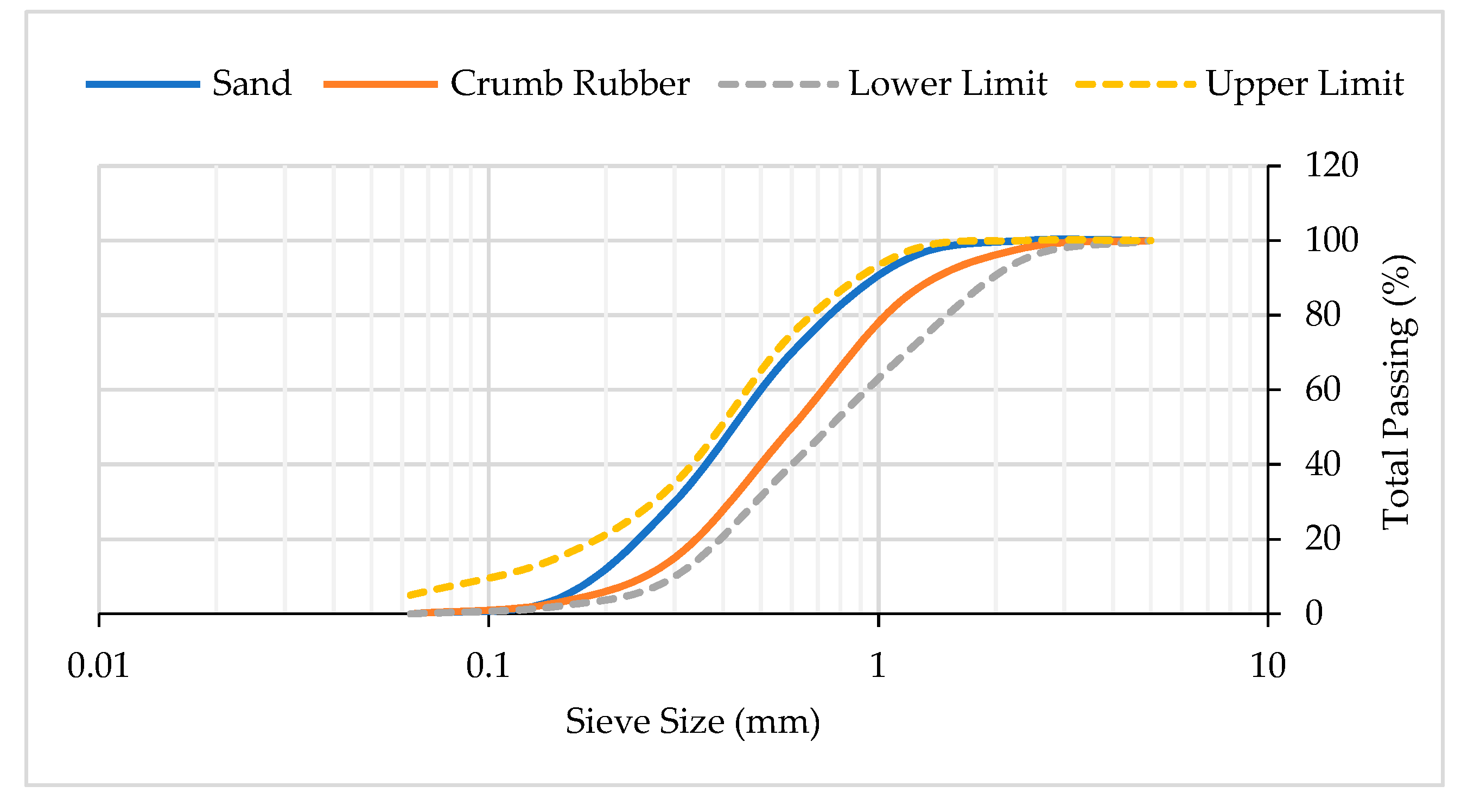
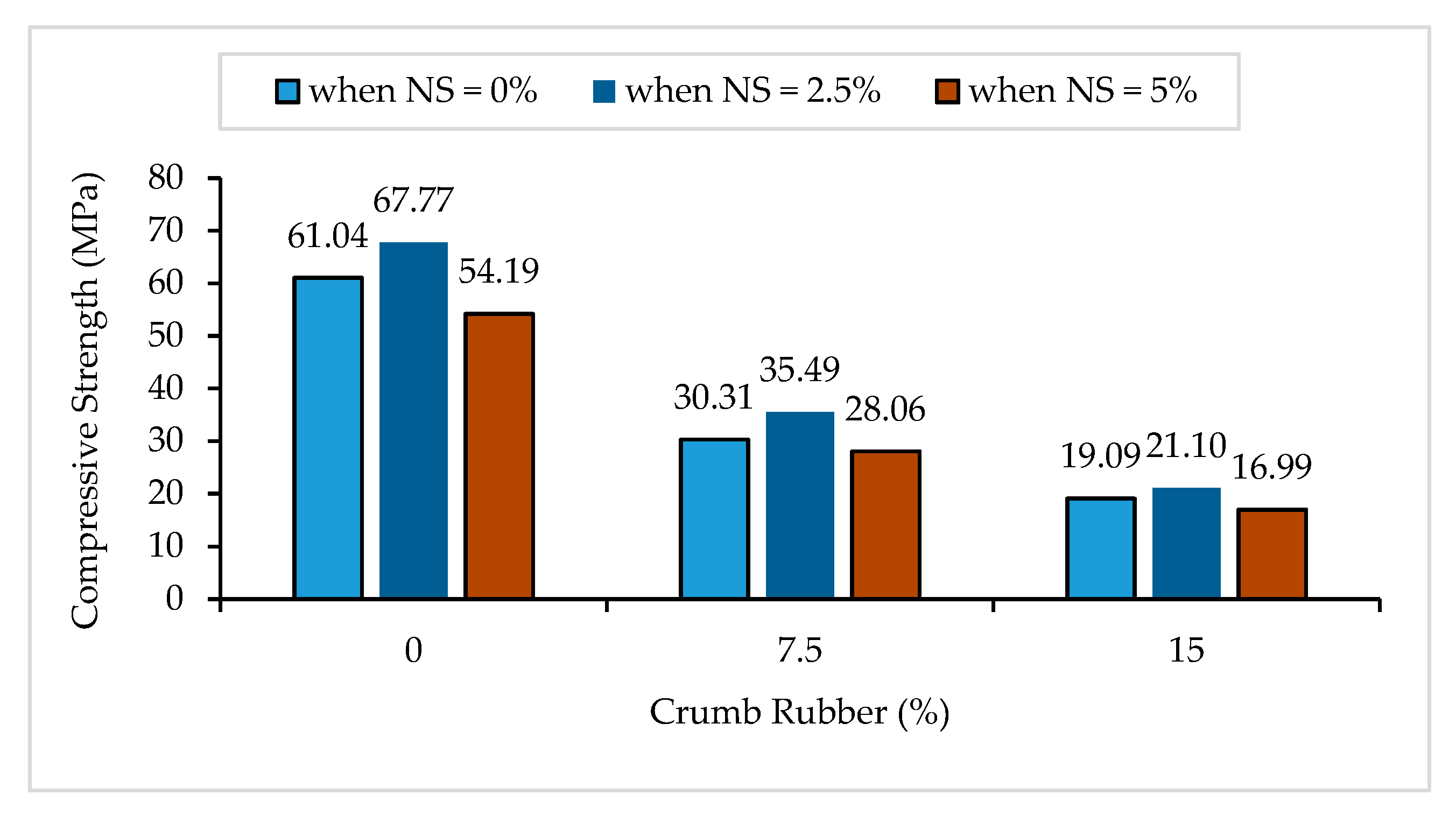

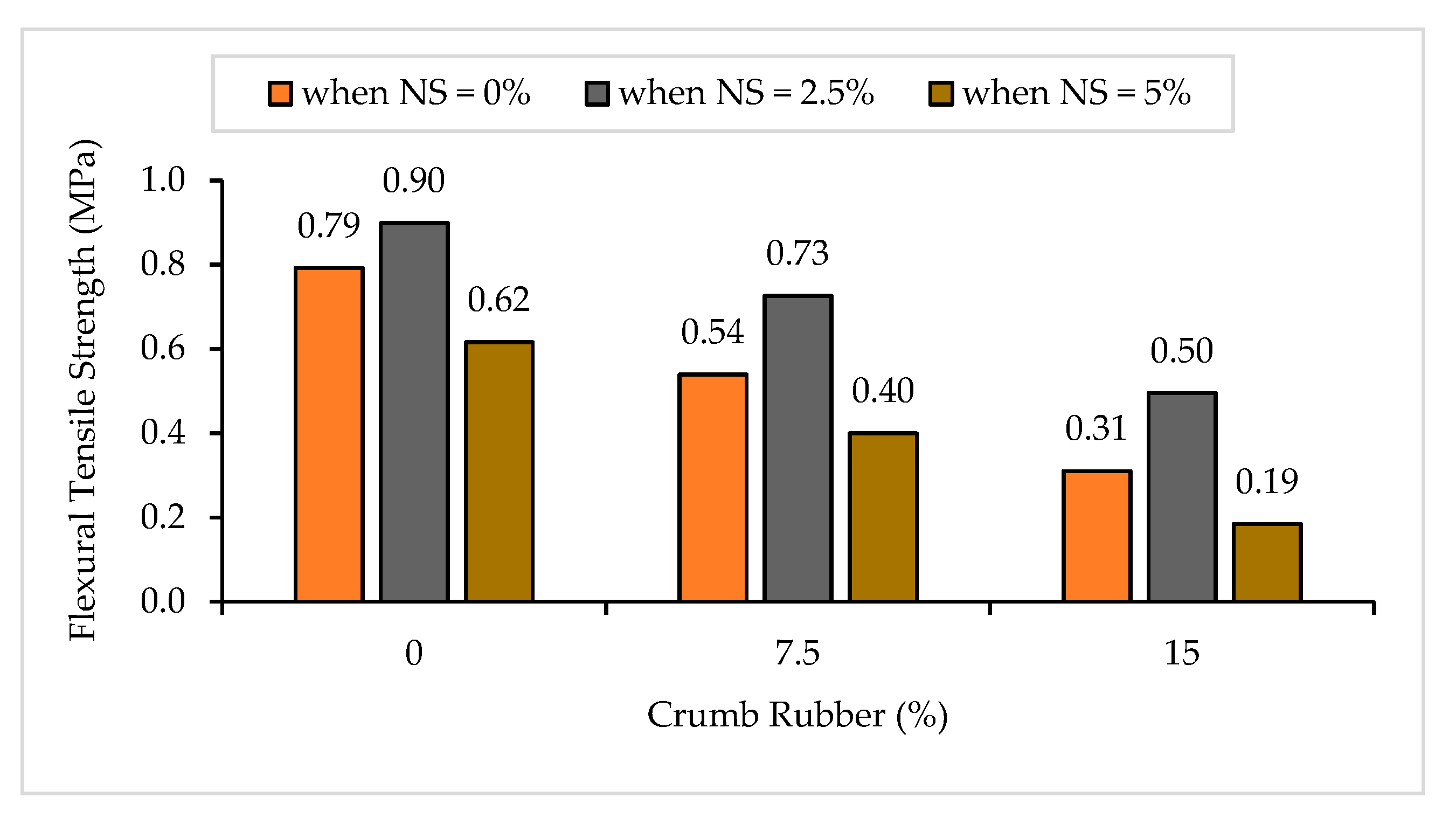

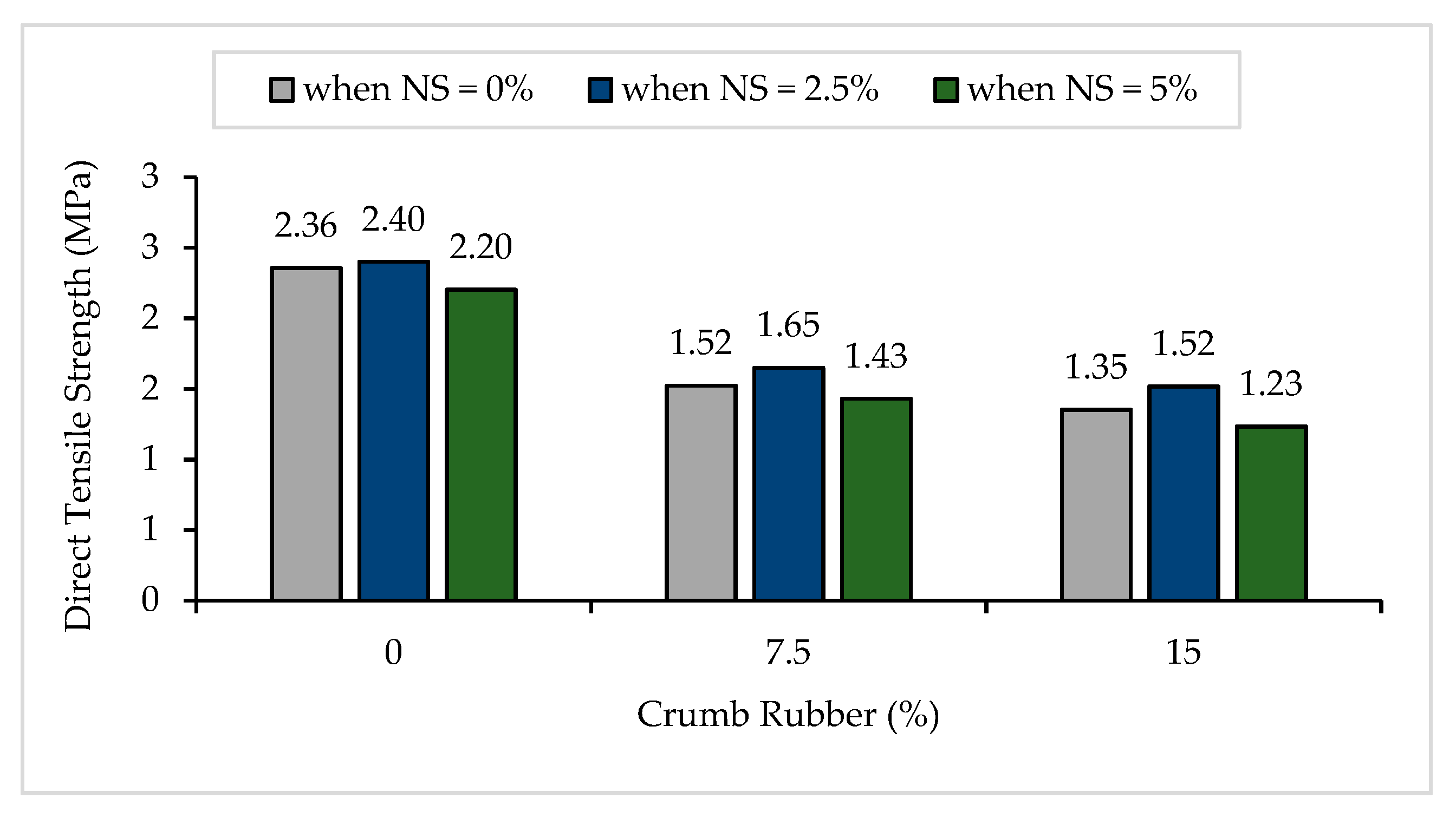

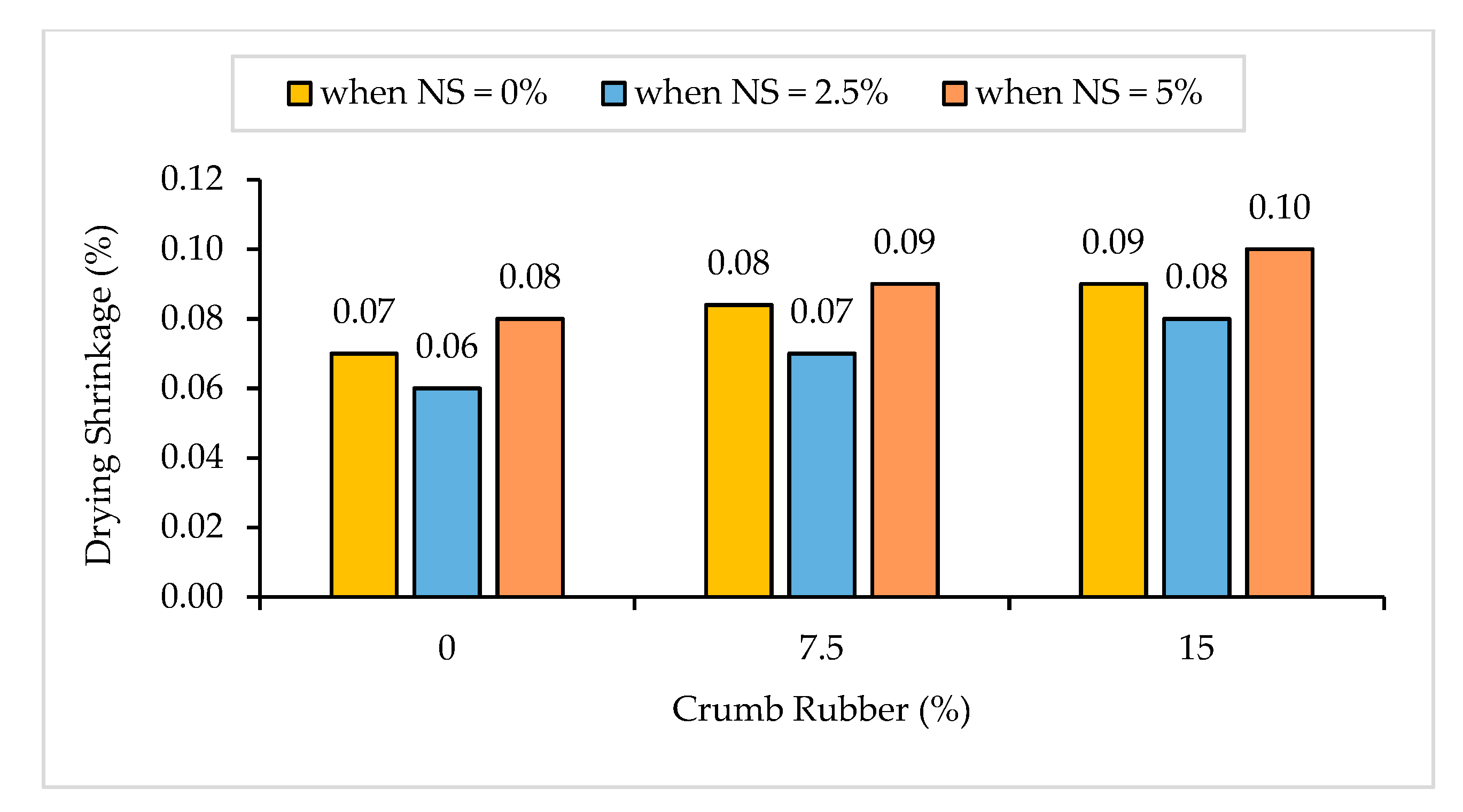
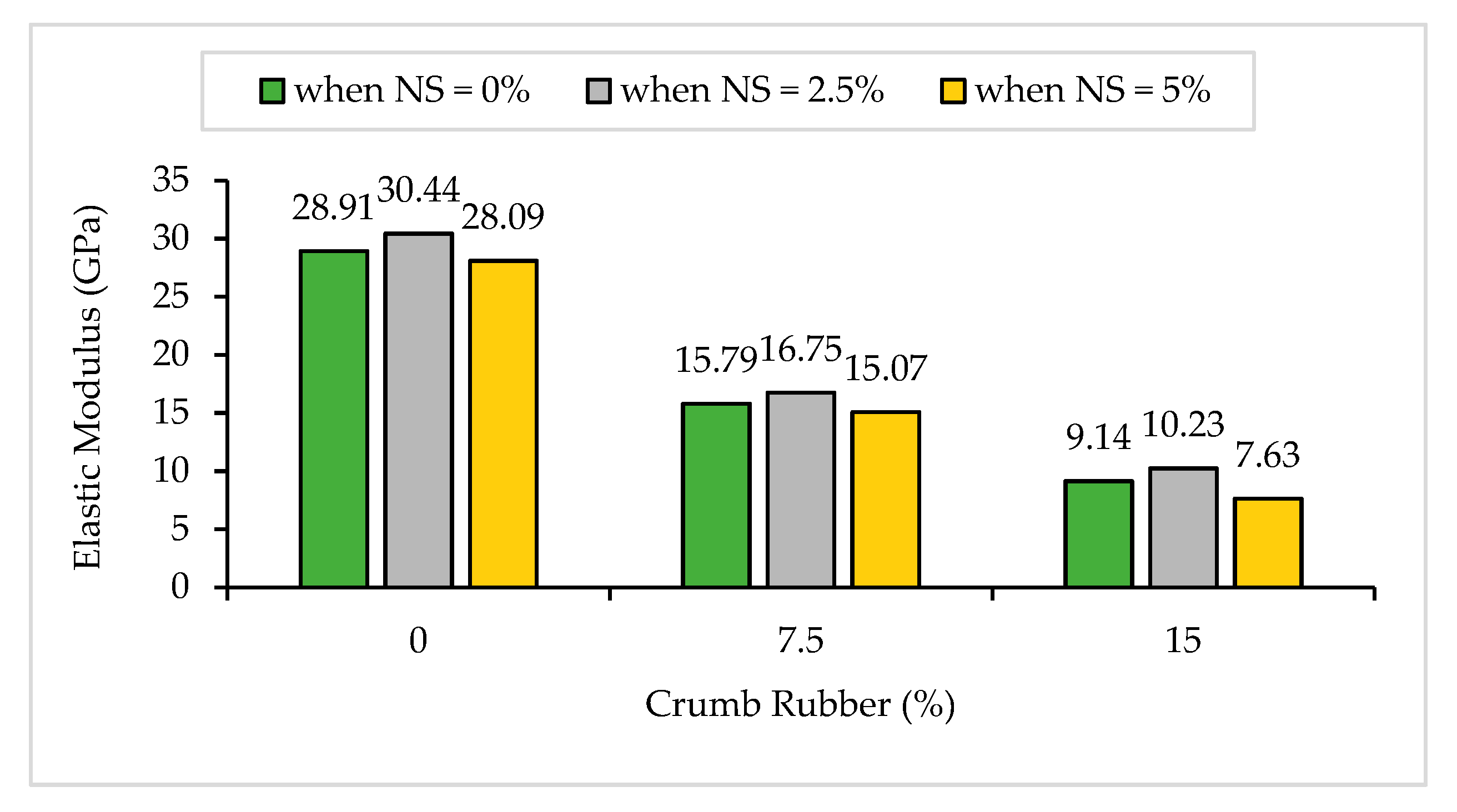

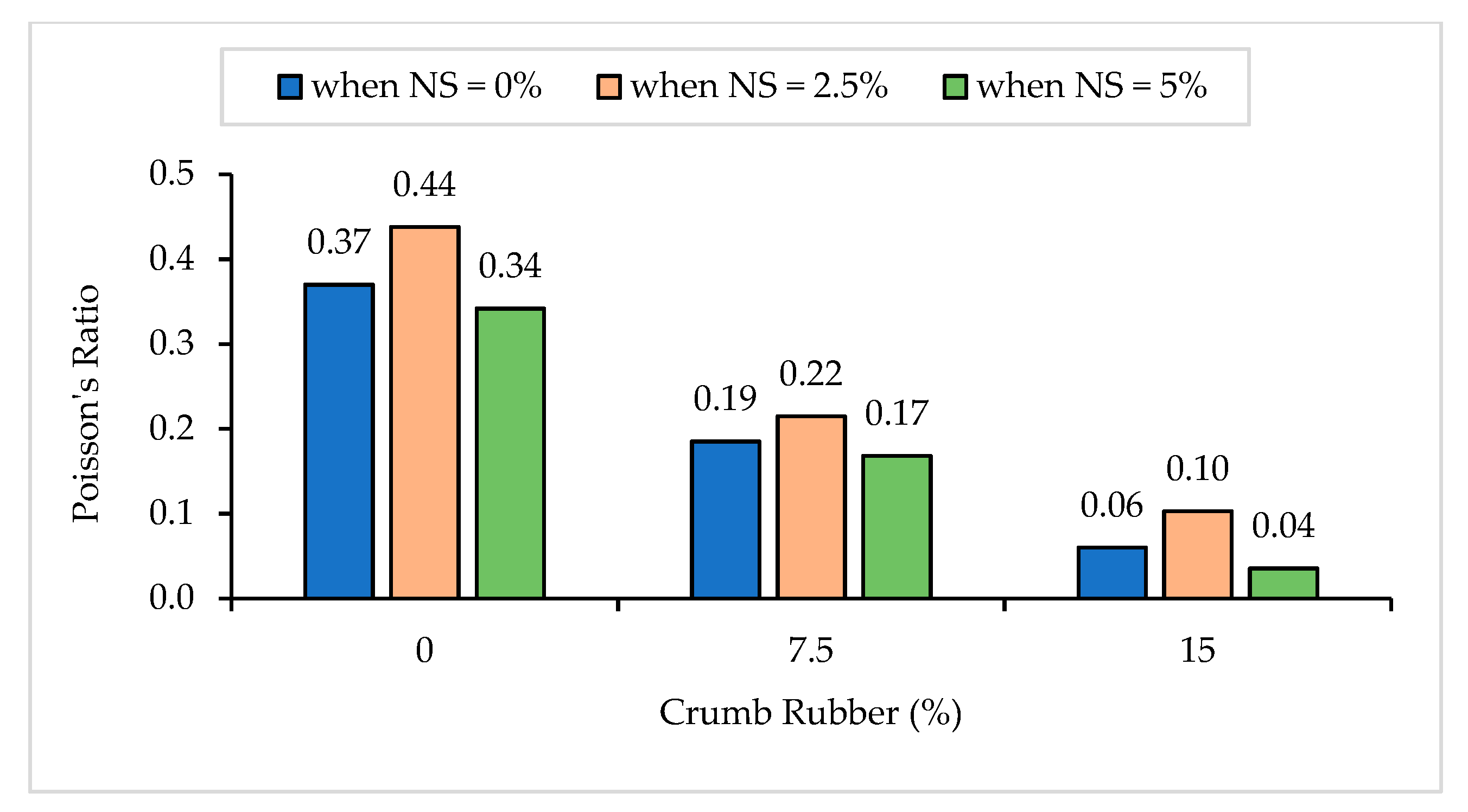
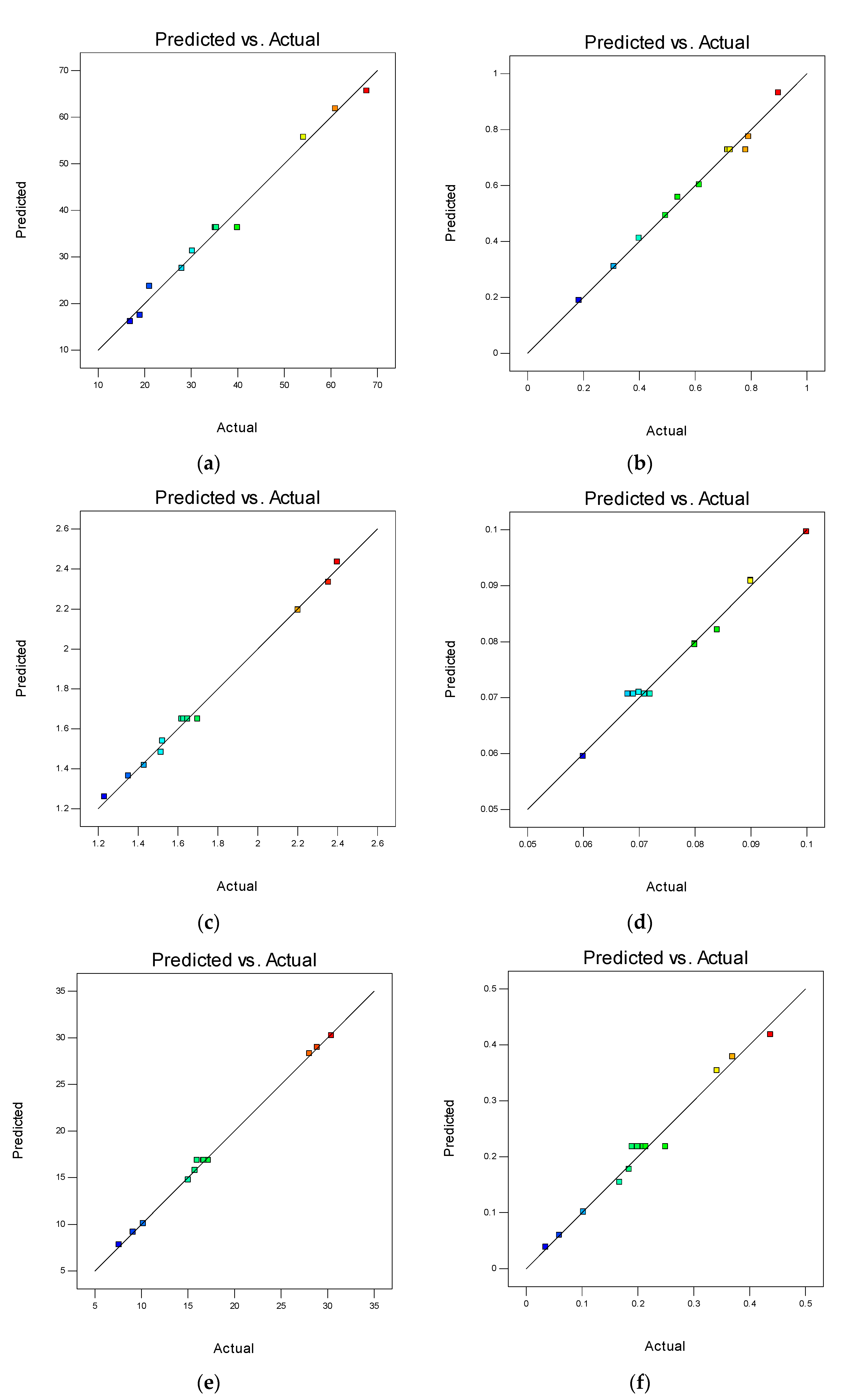
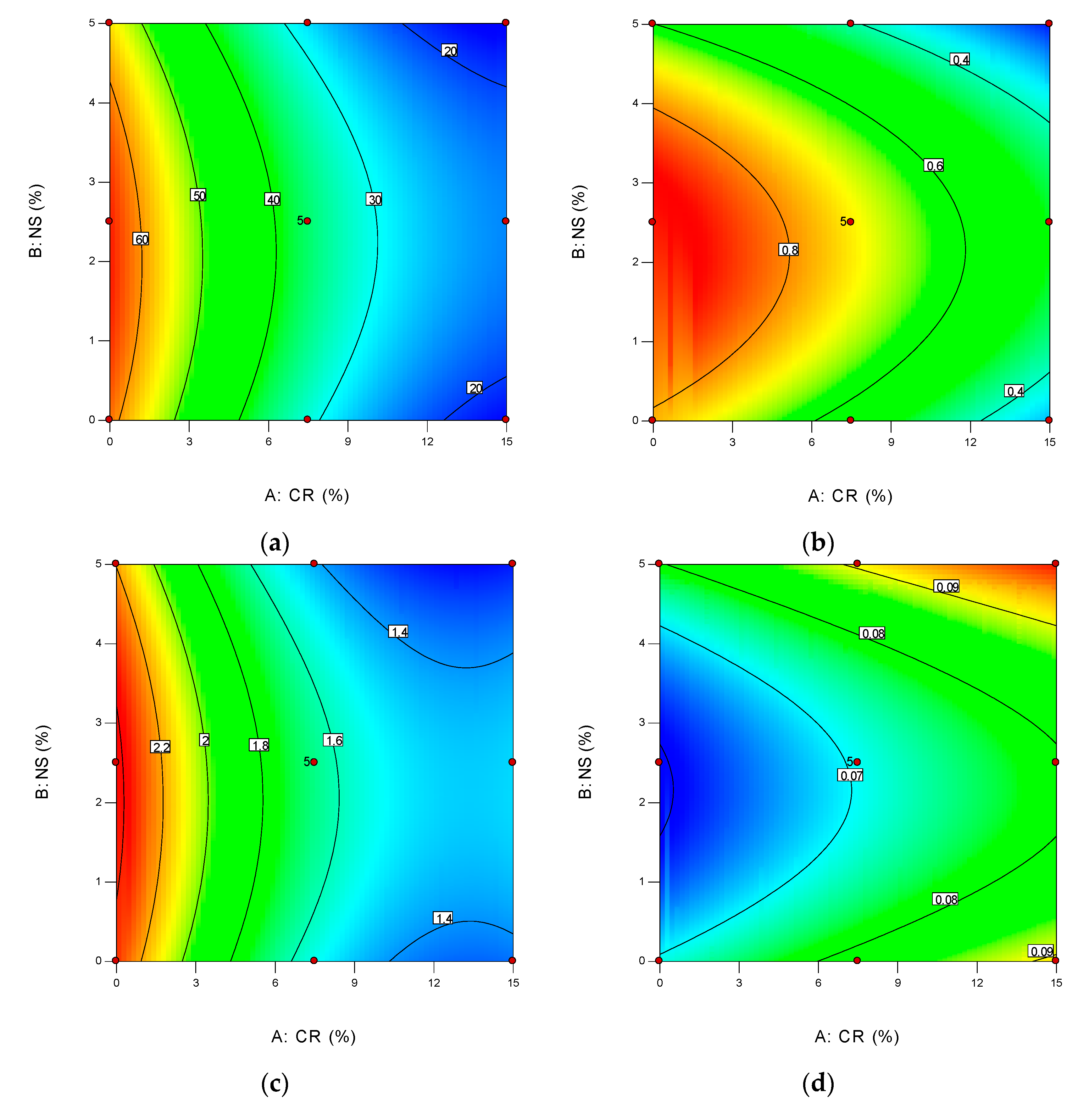
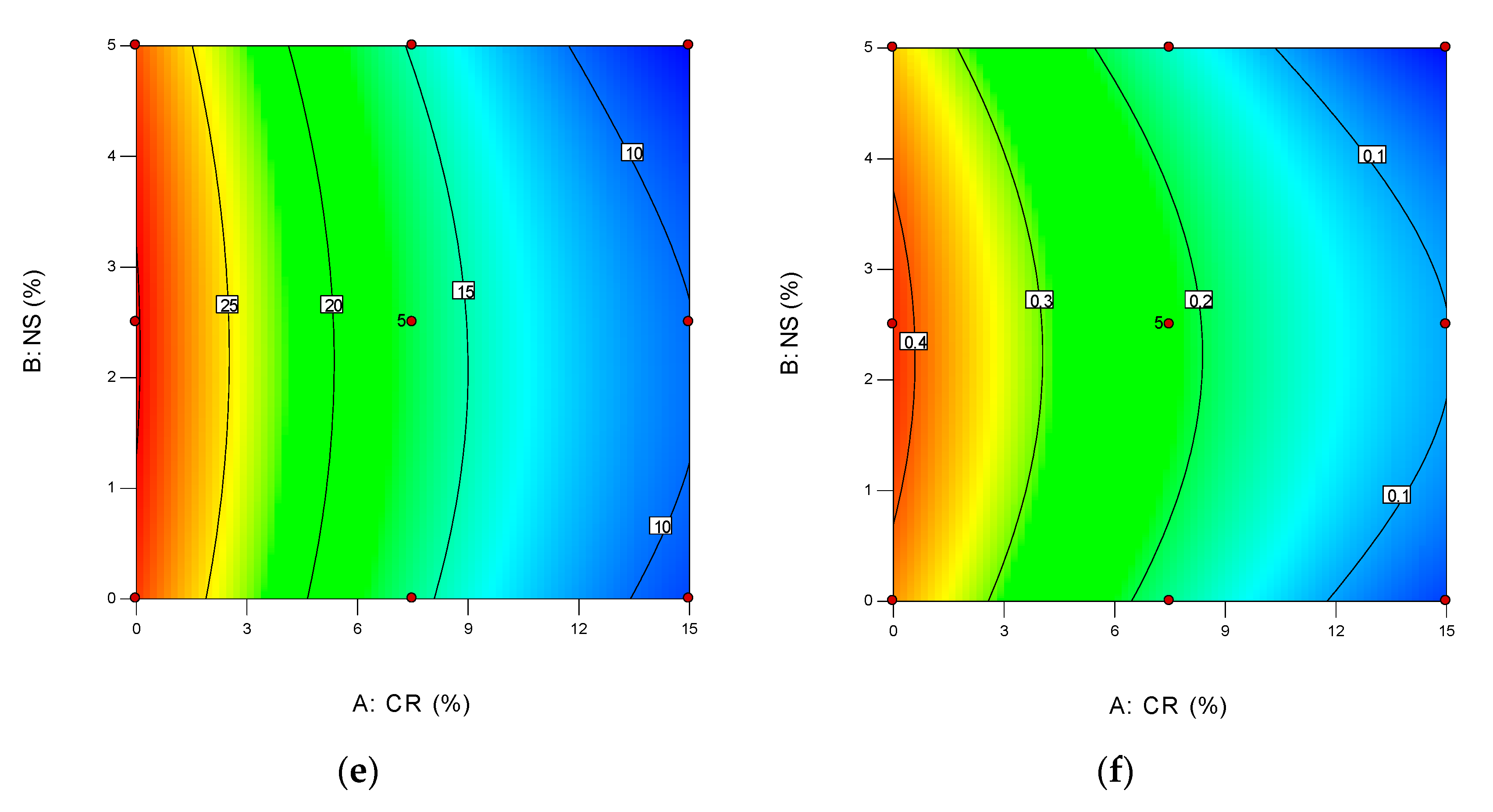
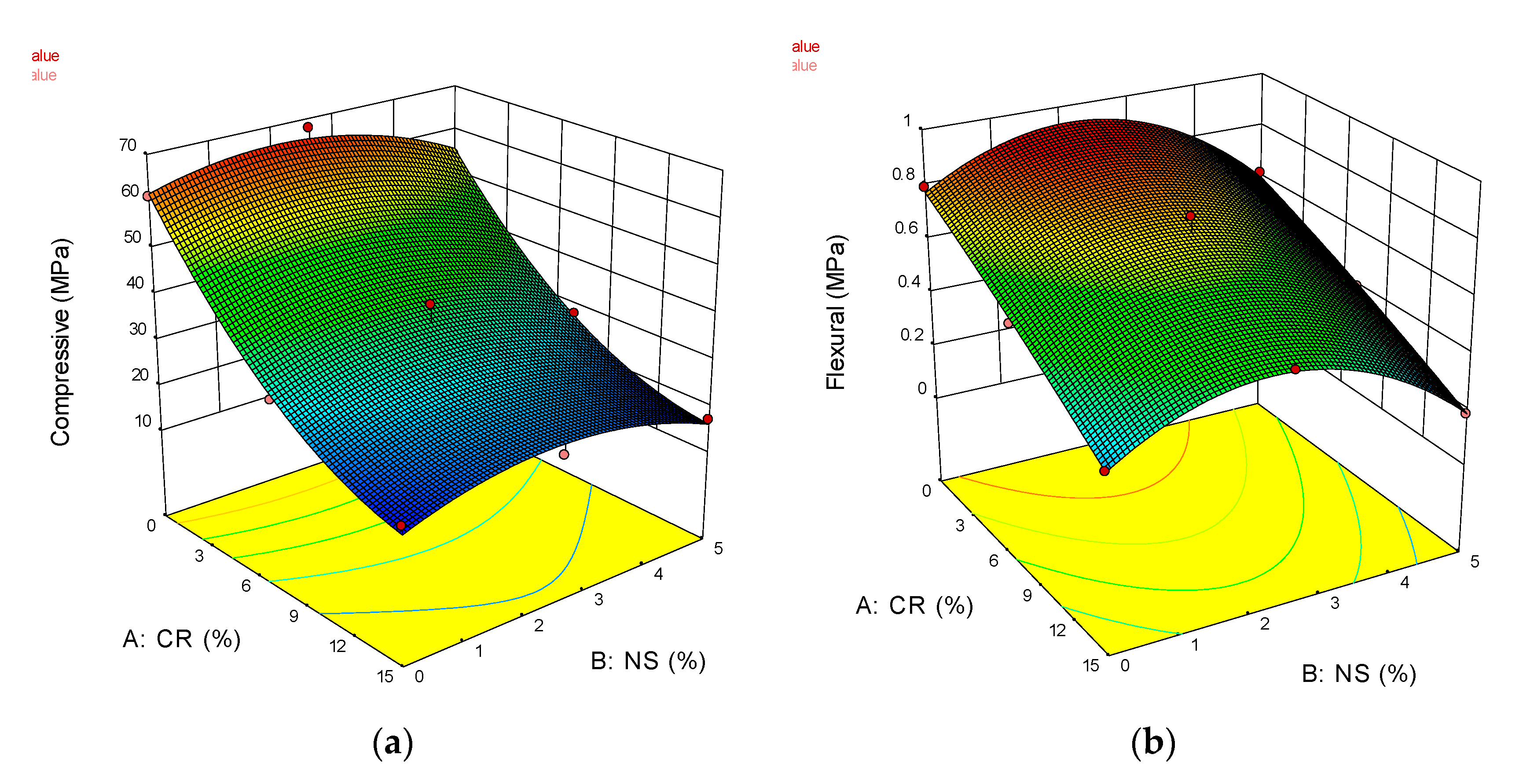
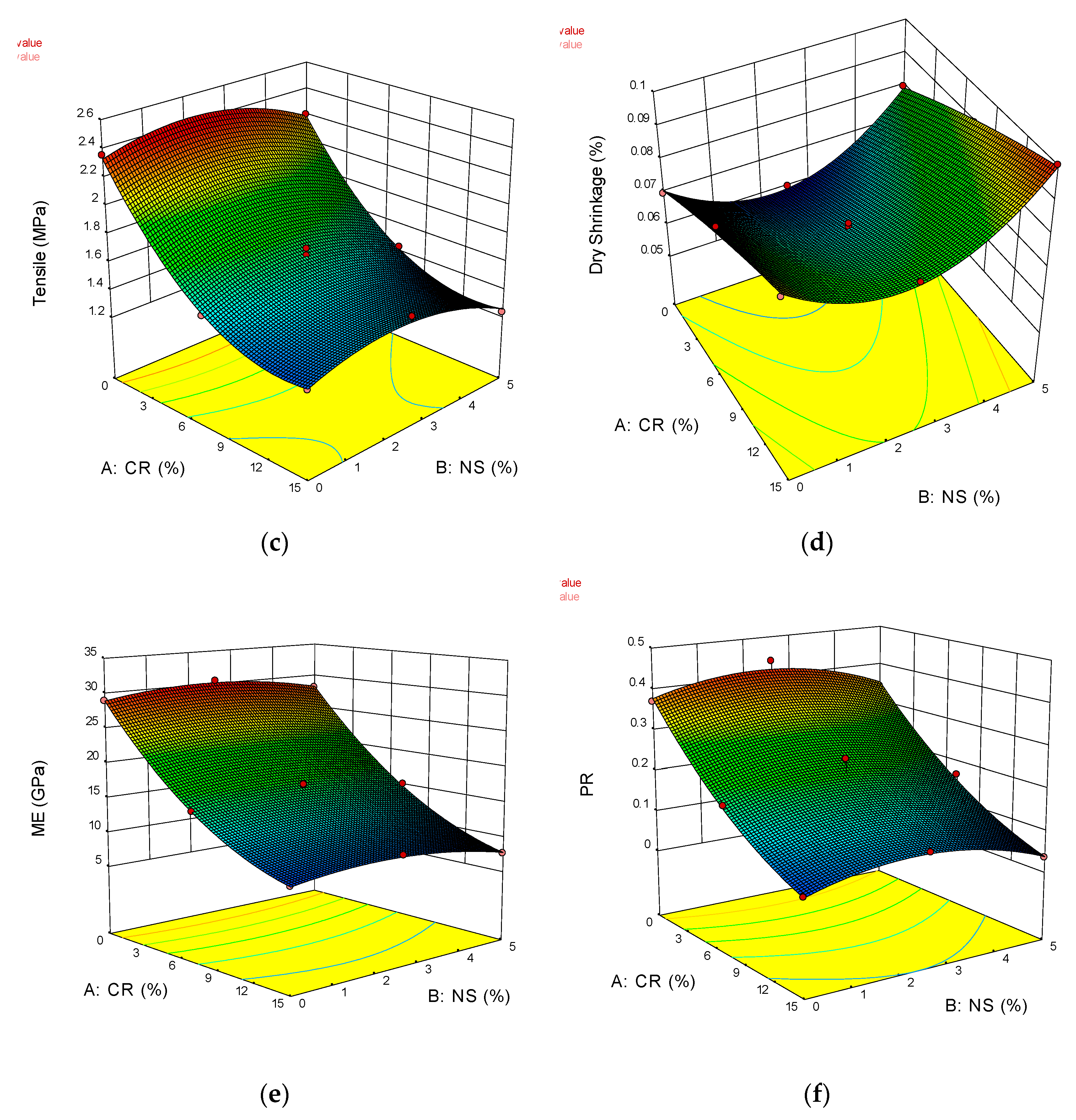
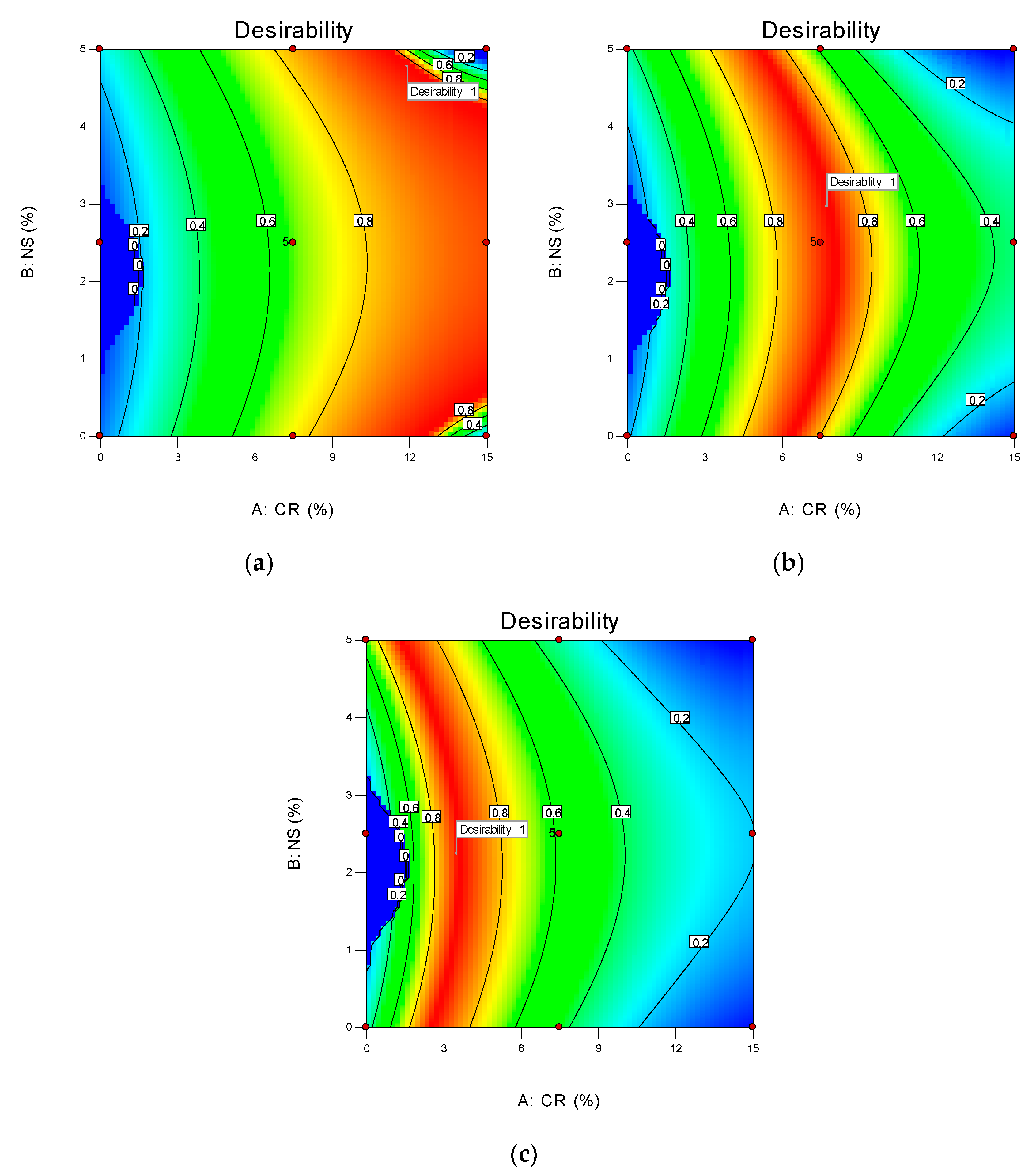
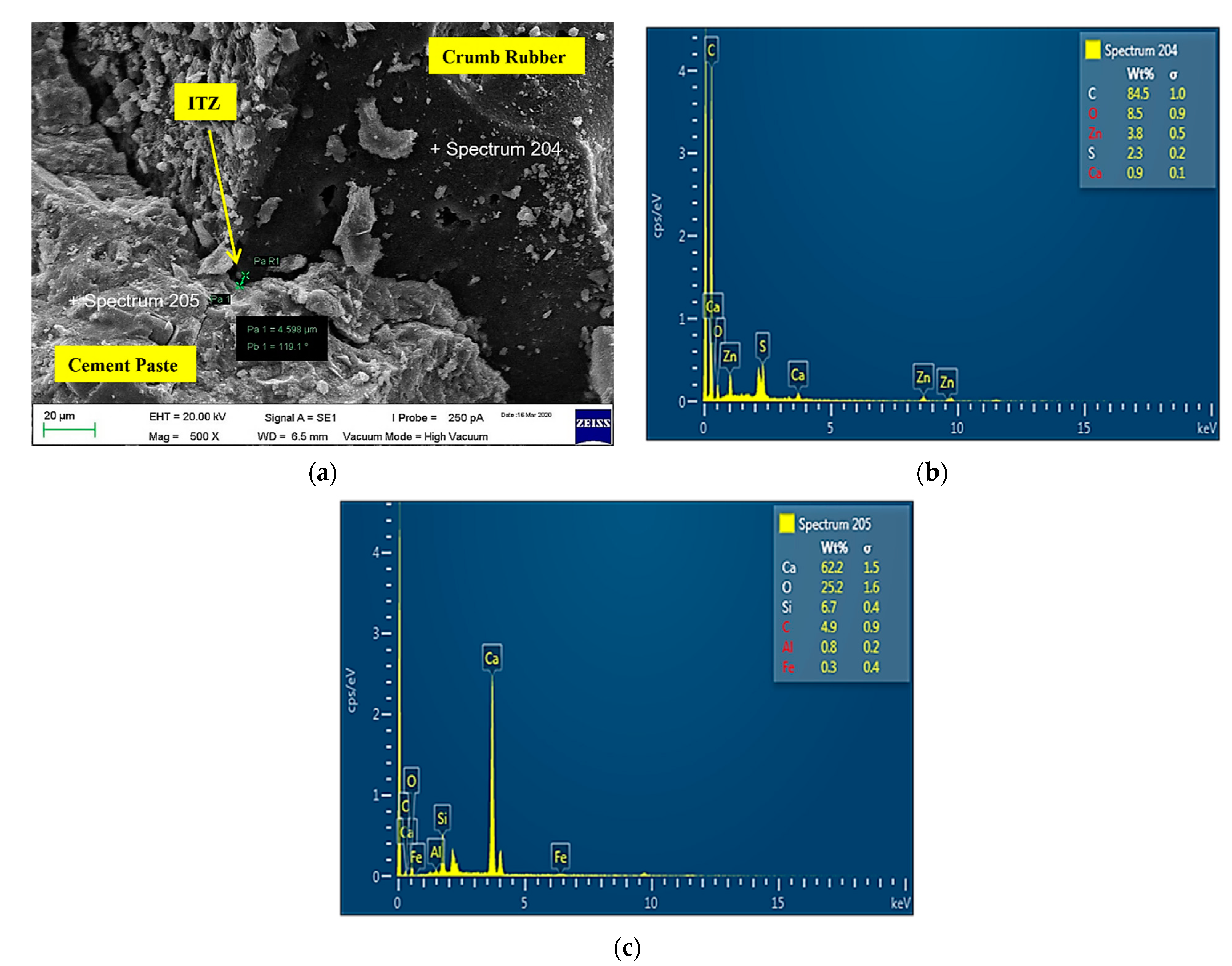
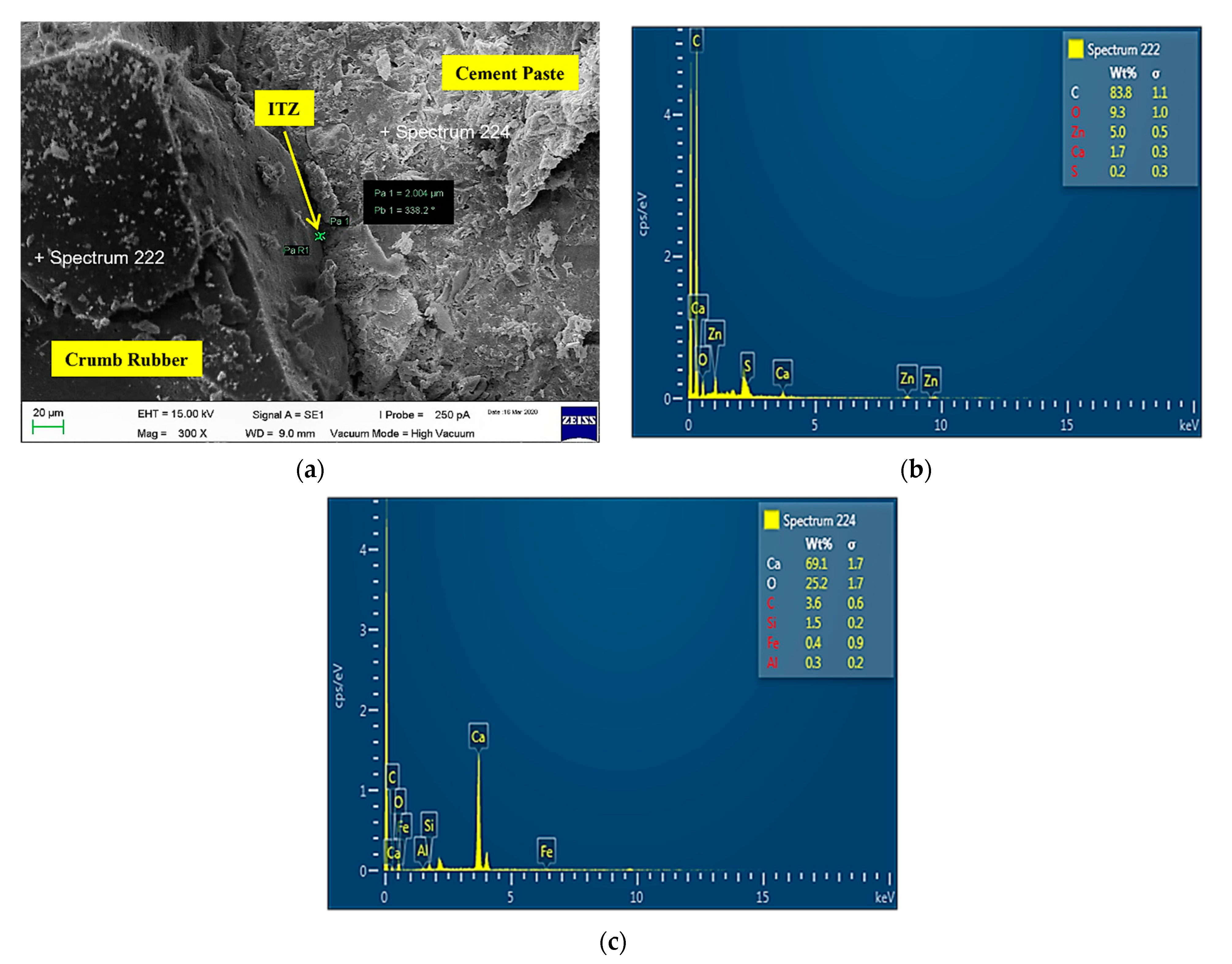
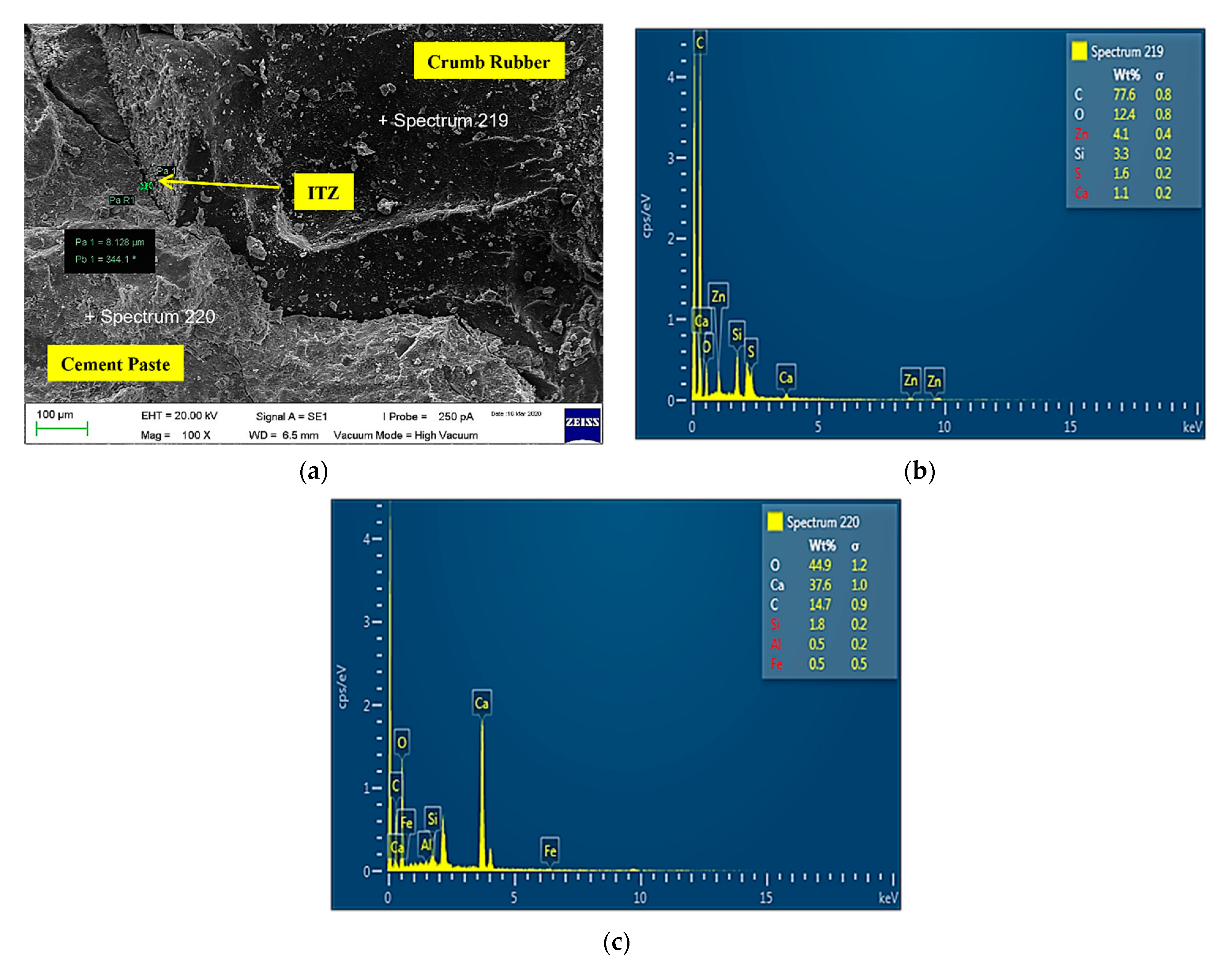
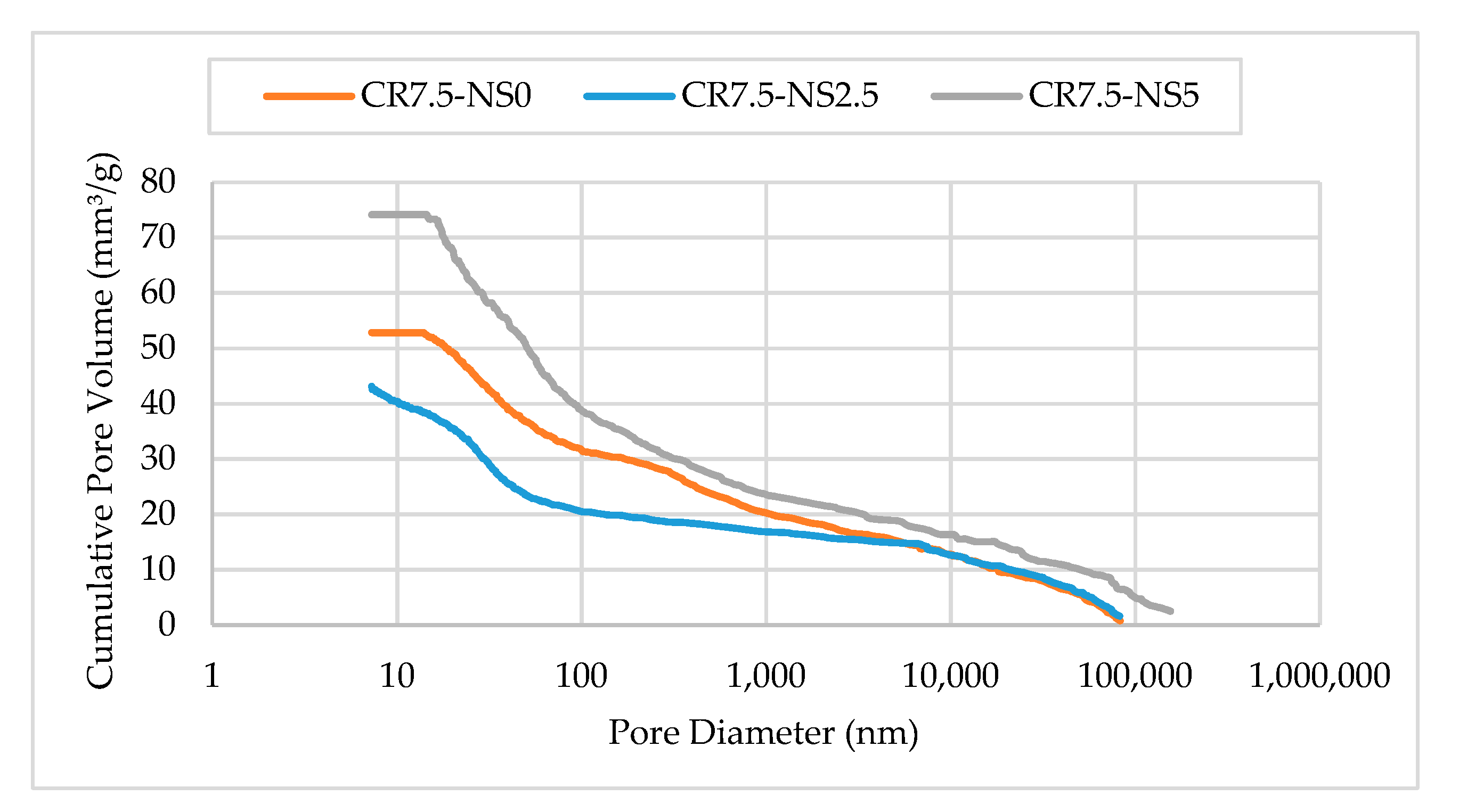
| Chemical Compositions | Cement (%) | Nano-Silica (%) |
|---|---|---|
| CaO | 62.85 | – |
| SiO2 | 25.21 | 99.80 |
| Al2O3 | 4.59 | – |
| Fe2O3 | 2.99 | – |
| MgO | 1.70 | – |
| Na2O | 0.98 | – |
| K2O | 1.68 | – |
| Loss of Ignition | 2.02 | 6.00 |
| Physical Properties | Cement | Nano-Silica |
|---|---|---|
| Specific Gravity (kg/cm3) | 3.15 | – |
| Density (g/cm3) | 3.02 | 0.15 |
| Average Particle Size (nm) | 13 | 10–25 |
| Specific Surface Area (cm2/g) | 0.38 | 100 ± 25 |
| Physical Properties | Sand | Crumb Rubber |
|---|---|---|
| Specific Gravity (kg/cm3) | 2.65 | 0.95 |
| Fineness Modulus | 2.20 | 0.92 |
| Water Absorption (%) | 2.10 | – |
| Moisture Content (%) | 1.30 | – |
| Chemical Composition | Aqueous solution of modified polycarboxylates |
| Appearance/Color | Brownish liquid, clear to slightly cloudy |
| pH-value | 3–5 |
| Total Chloride Ion Content (%) | <0.1 |
| No | Mix | Cement (kg/m3) | Sand (kg/m3) | Water (kg/m3) | NS (kg/m3) | CR (kg/m3) | SP (kg/m3) |
|---|---|---|---|---|---|---|---|
| 1 | CR0-NS0 | 0.1126 | 0.1688 | 0.0394 | 0.0000 | 0.0000 | 0.0198 |
| 2 | CR7.5-NS0 | 0.1126 | 0.1560 | 0.0394 | 0.0000 | 0.0126 | 0.0228 |
| 3 | CR15-NS0 | 0.1126 | 0.1434 | 0.0394 | 0.0000 | 0.0254 | 0.0361 |
| 4 | CR0-NS2.5 | 0.1096 | 0.1688 | 0.0394 | 0.0028 | 0.0000 | 0.0217 |
| 5 | CR7.5-NS2.5 | 0.1096 | 0.1560 | 0.0394 | 0.0028 | 0.0126 | 0.0257 |
| 6 | CR7.5-NS2.5 | 0.1096 | 0.1560 | 0.0394 | 0.0028 | 0.0126 | 0.0255 |
| 7 | CR7.5-NS2.5 | 0.1096 | 0.1560 | 0.0394 | 0.0028 | 0.0126 | 0.0260 |
| 8 | CR7.5-NS2.5 | 0.1096 | 0.1560 | 0.0394 | 0.0028 | 0.0126 | 0.0250 |
| 9 | CR7.5-NS2.5 | 0.1096 | 0.1560 | 0.0394 | 0.0028 | 0.0126 | 0.0263 |
| 10 | CR15-NS2.5 | 0.1096 | 0.1434 | 0.0394 | 0.0028 | 0.0254 | 0.0381 |
| 11 | CR0-NS5 | 0.1068 | 0.1688 | 0.0394 | 0.0056 | 0.0000 | 0.0228 |
| 12 | CR7.5-NS5 | 0.1068 | 0.1560 | 0.0394 | 0.0056 | 0.0126 | 0.0283 |
| 13 | CR15-NS5 | 0.1068 | 0.1434 | 0.0394 | 0.0056 | 0.0254 | 0.0400 |
| Tests | Specimens | Size of Molds (mm) | Test Machines | Test Conditions | Standards |
|---|---|---|---|---|---|
| Sieve Analysis | – | – | Sieve Shaker Machines | Operate machine for 15 to 20 min | ASTM C136/C136M-14 [38] |
| Flow Table | – | – | Flow Table with Mold and Tamping Rod | Acceptable flow of 110 ± 5% with 25 drops in 15 s | ASTM C1437-13 [39] |
| Compressive Strength | Cube | 50 × 50 × 50 | ELE ADR 3000 Machine | Continuous load rate of 0.9 kN/s | ASTM C109/C109M-16a [40] |
| Flexural Tensile Strength | Prism | 25 × 100 × 500 | 200 kN Universal Testing Machine | Continuous speed rate of 5 mm/min | ASTM C348-18 [41] |
| Direct Tensile Strength | Dog-bone | 50 × 200 × 25 | 200 kN Universal Testing Machine | Gradual speed rate of 0.15 mm/s | ASTM D2936-20 [42] |
| Drying Shrinkage | Two-gang Prism | 285 × 25 × 30 | Digital Vernier Caliper | Store in room with temperature of 20 ± 2 °C | ASTM C596-18 [43] |
| Poisson’s Ratio | Cylinder | 150 × 300 | Digital Dial Gauge Compressometer– Extensometer and ELE ADR 3000 Machine | Continuous load rate of 5.3 kN/s | ASTM C469/C469M-14 [44] |
| Modulus of Elasticity | |||||
| SEM | Crushed sample | – | Pascal 440 EVO Machine | Crushed sample size of 1 × 1 cm | ASTM C1723-16 [45] |
| MIP | Crushed sample | – | EVO LS15 Machine | Crushed sample size of 1 × 1 cm | ASTM D4404-18 [46] |
| No | Mix | CR (%) | NS (%) | σc (MPa) | σf (MPa) | σd (MPa) | Dry Shrinkage (%) | ME (GPa) | PR |
|---|---|---|---|---|---|---|---|---|---|
| 1 | CR0-NS0 | 0 | 0 | 61.04 | 0.79 | 2.36 | 0.07 | 28.91 | 0.37 |
| 2 | CR7.5-NS0 | 7.5 | 0 | 30.31 | 0.54 | 1.52 | 0.08 | 15.79 | 0.19 |
| 3 | CR15-NS0 | 15 | 0 | 19.09 | 0.31 | 1.35 | 0.09 | 9.14 | 0.06 |
| 4 | CR0-NS2.5 | 0 | 2.5 | 67.77 | 0.90 | 2.40 | 0.06 | 30.44 | 0.44 |
| 5 | CR7.5-NS2.5 | 7.5 | 2.5 | 35.49 | 0.73 | 1.65 | 0.07 | 16.74 | 0.22 |
| 6 | CR7.5-NS2.5 | 7.5 | 2.5 | 35.45 | 0.78 | 1.63 | 0.07 | 16.01 | 0.25 |
| 7 | CR7.5-NS2.5 | 7.5 | 2.5 | 36.11 | 0.72 | 1.64 | 0.07 | 17.23 | 0.20 |
| 8 | CR7.5-NS2.5 | 7.5 | 2.5 | 34.90 | 0.72 | 1.66 | 0.07 | 17.08 | 0.19 |
| 9 | CR7.5-NS2.5 | 7.5 | 2.5 | 35.50 | 0.72 | 1.67 | 0.07 | 16.71 | 0.21 |
| 10 | CR15-NS2.5 | 15 | 2.5 | 21.10 | 0.50 | 1.52 | 0.08 | 10.23 | 0.10 |
| 11 | CR0-NS5 | 0 | 5 | 54.19 | 0.62 | 2.20 | 0.08 | 28.09 | 0.34 |
| 12 | CR7.5-NS5 | 7.5 | 5 | 28.06 | 0.40 | 1.43 | 0.09 | 15.07 | 0.17 |
| 13 | CR15-NS5 | 15 | 5 | 16.99 | 0.19 | 1.23 | 0.10 | 7.63 | 0.04 |
| Responses | Variables | SS | DF | µ2 | F-Values | p-Values Prob > F | Significant |
|---|---|---|---|---|---|---|---|
| Compressive Strength | Model | 2902.57 | 5 | 580.51 | 113.91 | <0.0001 | Yes |
| A-CR | 2638.45 | 1 | 2638.45 | 517.71 | <0.0001 | Yes | |
| B-NS | 20.91 | 1 | 20.91 | 4.10 | 0.0825 | No | |
| AB | 5.64 | 1 | 5.64 | 1.11 | 0.3277 | No | |
| A2 | 193.72 | 1 | 193.72 | 38.01 | 0.0005 | Yes | |
| B2 | 130.54 | 1 | 130.54 | 25.61 | 0.0015 | Yes | |
| Lack of Fit | 18.61 | 3 | 6.20 | 1.45 | 0.3527 | No | |
| Flexural Tensile Strength | Model | 0.52 | 5 | 0.10 | 138.81 | <0.0001 | Yes |
| A-CR | 0.29 | 1 | 0.29 | 383.96 | <0.0001 | Yes | |
| B-NS | 0.032 | 1 | 0.032 | 42.86 | 0.0003 | Yes | |
| AB | 6.50 × 10−4 | 1 | 6.50 × 10−4 | 0.86 | 0.3836 | No | |
| A2 | 6.53 × 10−4 | 1 | 6.53 × 10−4 | 0.87 | 0.3827 | No | |
| B2 | 0.16 | 1 | 0.16 | 216.39 | <0.0001 | Yes | |
| Lack of Fit | 2.17 × 10−3 | 3 | 7.23 × 10−4 | 0.93 | 0.5031 | No | |
| Direct Tensile Strength | Model | 1.66 | 5 | 0.33 | 285.63 | <0.0001 | Yes |
| A-CR | 1.36 | 1 | 1.36 | 1172.76 | <0.0001 | Yes | |
| B-NS | 0.022 | 1 | 0.022 | 19.15 | 0.0032 | Yes | |
| AB | 2.72 × 10−4 | 1 | 2.72 × 10−4 | 0.23 | 0.6427 | No | |
| A2 | 0.26 | 1 | 0.26 | 228.10 | <0.0001 | Yes | |
| B2 | 0.081 | 1 | 0.081 | 69.74 | <0.0001 | Yes | |
| Lack of Fit | 4.23 × 10−3 | 3 | 1.41 × 10−3 | 1.46 | 0.3527 | No | |
| Drying Shrinkage | Model | 1.48 × 10−3 | 5 | 2.96 × 10−4 | 102.13 | <0.0001 | Yes |
| A-CR | 6.00 × 10−4 | 1 | 6.00 × 10−4 | 206.91 | <0.0001 | Yes | |
| B-NS | 1.13 × 10−4 | 1 | 1.13 × 10−4 | 38.85 | 0.0004 | Yes | |
| AB | 0.00 | 1 | 0.00 | 0.00 | 1.0000 | No | |
| A2 | 3.80 × 10−6 | 1 | 3.80 × 10−6 | 1.31 | 0.2902 | No | |
| B2 | 6.92 × 10−4 | 1 | 6.92 × 10−4 | 238.60 | <0.0001 | Yes | |
| Lack of Fit | 7.10 × 10−6 | 3 | 2.37 × 10−6 | 0.72 | 0.5915 | No | |
| Modulus of Elasticity | Model | 641.06 | 5 | 128.21 | 765.52 | <0.0001 | Yes |
| A-CR | 608.79 | 1 | 608.79 | 3634.91 | <0.0001 | Yes | |
| B-NS | 1.55 | 1 | 1.55 | 9.26 | 0.0188 | Yes | |
| AB | 0.12 | 1 | 0.12 | 0.71 | 0.4277 | No | |
| A2 | 30.23 | 1 | 30.23 | 180.51 | <0.0001 | Yes | |
| B2 | 7.06 | 1 | 7.06 | 42.14 | 0.0003 | Yes | |
| Lack of Fit | 0.28 | 3 | 0.095 | 0.43 | 0.7454 | No | |
| Poisson’s Ratio | Model | 0.16 | 5 | 0.032 | 73.58 | <0.0001 | Yes |
| A-CR | 0.15 | 1 | 0.15 | 345.32 | <0.0001 | Yes | |
| B-NS | 8.05 × 10−4 | 1 | 8.05 × 10−4 | 1.84 | 0.2168 | No | |
| AB | 3.06 × 10−6 | 1 | 3.06 × 10−6 | 7.01 × 10−3 | 0.9356 | No | |
| A2 | 4.87 × 10−3 | 1 | 4.87 × 10−3 | 11.14 | 0.0124 | Yes | |
| B2 | 7.47 × 10−3 | 1 | 7.47 × 10−3 | 17.1 | 0.0044 | Yes | |
| Lack of Fit | 9.79 × 10−4 | 3 | 3.26 × 10−4 | 0.63 | 0.6344 | No |
| Responses | SD | µ | R2 | Adj R2 | Pred R2 | AP |
|---|---|---|---|---|---|---|
| Compressive Strength | 2.26 | 36.93 | 0.99 | 0.98 | 0.93 | 32.27 |
| Flexural Tensile Strength | 0.03 | 0.61 | 0.99 | 0.98 | 0.96 | 39.83 |
| Direct Tensile Strength | 0.034 | 1.71 | 1 | 0.99 | 0.97 | 50.83 |
| Drying Shrinkage | 1.70 × 10−3 | 0.077 | 0.99 | 0.98 | 0.94 | 34.72 |
| Modulus of Elasticity | 0.41 | 17.62 | 1 | 1 | 0.99 | 80.66 |
| Poisson’s Ratio | 0.021 | 0.21 | 0.98 | 0.97 | 0.94 | 26.75 |
| Variables and Responses | Goals | Lower Limits | Upper Limits |
|---|---|---|---|
| Crumb Rubber (%) | In Range | 0 | 15 |
| Nano-Silica (%) | In Range | 0 | 5 |
| Compressive Strength (MPa) | Target: 20, 35, 50 MPa | 16.99 | 67.77 |
| Flexural Tensile Strength (MPa) | In Range | 0.19 | 0.90 |
| Direct Tensile Strength (MPa) | In Range | 1.23 | 2.40 |
| Drying Shrinkage (%) | In Range | 0.06 | 0.10 |
| Modulus of Elasticity (GPa) | In Range | 7.63 | 30.44 |
| Poisson’s Ratio | In Range | 0.04 | 0.44 |
| Mix | Validation | σc (MPa) | σf (MPa) | σd (MPa) | DS (%) | ME (GPa) | PR |
|---|---|---|---|---|---|---|---|
| CR12-NS5 | Predicted | 20.00 | 0.330 | 1.282 | 0.093 | 10.159 | 0.085 |
| Experimental | 19.58 | 0.322 | 1.249 | 0.091 | 9.894 | 0.083 | |
| Error (%) | 2.10 | 2.42 | 2.57 | 2.68 | 2.61 | 2.58 | |
| CR8-NS3 | Optimization | 35.00 | 0.698 | 1.616 | 0.072 | 16.365 | 0.208 |
| Experimental | 34.25 | 0.679 | 1.581 | 0.071 | 15.998 | 0.203 | |
| Error (%) | 2.14 | 2.72 | 2.17 | 2.07 | 2.24 | 2.40 | |
| CR3-NS2 | Optimization | 50.00 | 0.845 | 1.995 | 0.065 | 23.176 | 0.315 |
| Experimental | 48.96 | 0.826 | 1.955 | 0.063 | 22.623 | 0.307 | |
| Error (%) | 2.08 | 2.25 | 2.01 | 2.63 | 2.39 | 2.54 |
Publisher’s Note: MDPI stays neutral with regard to jurisdictional claims in published maps and institutional affiliations. |
© 2021 by the authors. Licensee MDPI, Basel, Switzerland. This article is an open access article distributed under the terms and conditions of the Creative Commons Attribution (CC BY) license (https://creativecommons.org/licenses/by/4.0/).
Share and Cite
Shahrul, S.; Mohammed, B.S.; Wahab, M.M.A.; Liew, M.S. Mechanical Properties of Crumb Rubber Mortar Containing Nano-Silica Using Response Surface Methodology. Materials 2021, 14, 5496. https://doi.org/10.3390/ma14195496
Shahrul S, Mohammed BS, Wahab MMA, Liew MS. Mechanical Properties of Crumb Rubber Mortar Containing Nano-Silica Using Response Surface Methodology. Materials. 2021; 14(19):5496. https://doi.org/10.3390/ma14195496
Chicago/Turabian StyleShahrul, Syafiqah, Bashar S. Mohammed, M. M. A. Wahab, and M. S. Liew. 2021. "Mechanical Properties of Crumb Rubber Mortar Containing Nano-Silica Using Response Surface Methodology" Materials 14, no. 19: 5496. https://doi.org/10.3390/ma14195496
APA StyleShahrul, S., Mohammed, B. S., Wahab, M. M. A., & Liew, M. S. (2021). Mechanical Properties of Crumb Rubber Mortar Containing Nano-Silica Using Response Surface Methodology. Materials, 14(19), 5496. https://doi.org/10.3390/ma14195496







